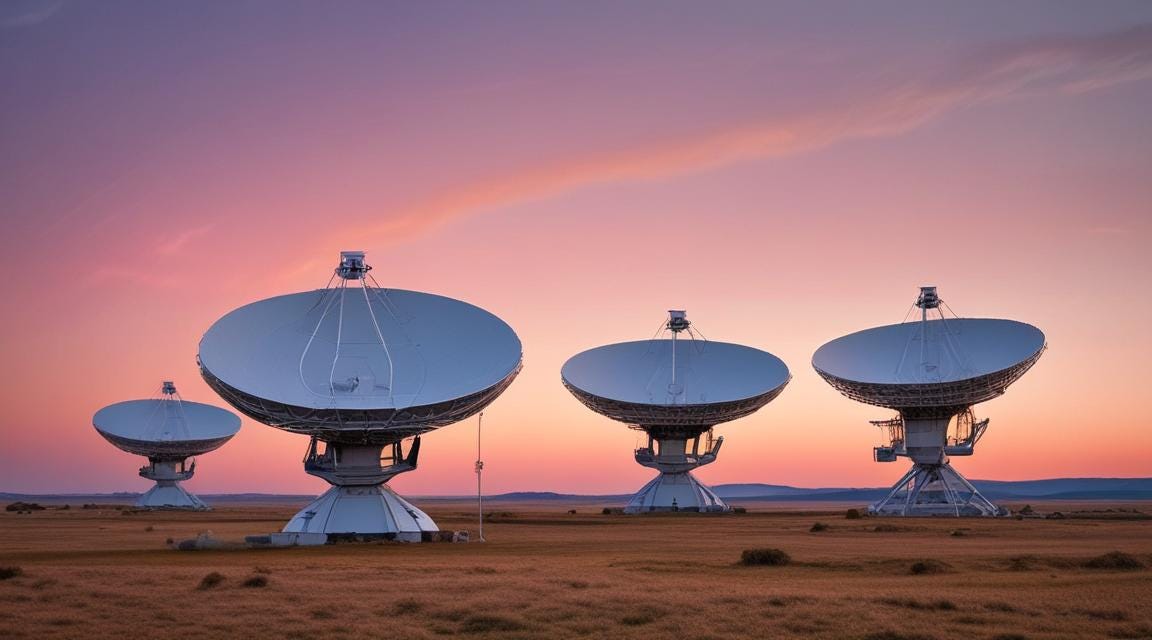Cosmic Pioneers: India's Role in Unveiling the Universe's Mysteries
The Giant Metrewave Radio Telescope and the Discovery of the Universe's Largest Black Hole Jets
In the vast and mysterious universe, a recent discovery has once again proven the prowess of Indian scientific research and its pivotal role in unravelling cosmic mysteries. At the heart of this landmark finding is an Indian radio telescope, which has played a crucial role in observing a significant black hole jet, shedding light on the dynamic processes that govern our universe.
“An Indian radio telescope played a pivotal role in discovering astronomers' largest pair of black hole jets, spanning 23 million light-years,” screamed media headlines.
Nestled in the picturesque village of Khodad, 80 km from Pune in Maharashtra, India, stands an unsung hero of cosmic exploration— the Giant Metrewave Radio Telescope (GMRT).
Critical cosmic signals picked up by the GMRT have aided an international team of astronomers in spotting the monstrous jets. Their length is equivalent to lining up 140 Milky Way galaxies back-to-back.
This remarkable facility, nestled amidst serene landscapes, played a pivotal role in one of the most astounding discoveries in astronomy: identifying the most giant pair of black hole jets ever observed, spanning a colossal 23 million light-years in total length.
The GMRT, with its array of 30 parabolic antennas, is renowned for detecting and analysing radio waves emitted by celestial objects. When this radio telescope picked up critical cosmic signals, the world of astronomy sat up and took notice. These signals were vital to unlocking the mysteries of distant galaxies and the enigmatic black holes at their centres.
The discovery has recently been published in Nature, the foremost science journal.
The discovery, published in Nature, sent ripples through the scientific community. The GMRT's contribution was hailed as instrumental in providing crucial insights into the nature of black holes and the dynamics of galaxies. The radio telescope's sensitivity and ability to capture faint radio emissions allowed astronomers to probe deeper into the cosmos and uncover hidden treasures.
Black holes, enigmatic regions of spacetime exhibiting such strong gravitational effects that nothing—not even particles and electromagnetic radiation such as light—can escape from inside them, have long captivated the imagination of scientists and laypersons alike. The recent discovery focuses on the jet ejected by a black hole, which occurs under specific conditions and is crucial for understanding the behaviour of black holes and the galaxies that host them.
An international team of astronomers, armed with data from the GMRT and other observatories, embarked on a journey to unravel the secrets of these colossal jets. Through meticulous analysis and collaboration, they pieced together the puzzle, revealing the sheer magnitude of the phenomenon. The jets, powered by the accretion of matter onto the supermassive black holes at the cores of their host galaxies, extended far beyond the galaxies themselves, stretching across millions of light-years.
Giant jets of fast-moving plasma emanate from the supermassive black holes at the centre of galaxies. These can be observed with radio telescopes. However, only a few jets are very long. Hence, this jet discovered is the largest so far,
The Indian radio telescope, part of an international collaboration, has provided critical data that has enhanced our understanding of these jets. This discovery places India on the global map of cutting-edge astronomical research and emphasises the importance of international collaboration in pursuing knowledge. The insights gained from this research could have profound implications for our understanding of galaxy formation, the behaviour of black holes, and the fundamental laws that govern the universe.
To determine the jets' lengths, a powerful radio telescope needed to trace them back to the galaxy from which they emerged. This is where the GMRT comes in. Once the host was identified using the GMRT, the researchers used the Keck I optical telescope in Hawaii, US, to obtain the distance.
This discovery is even more exciting because of its potential for future research. With Indian scientists and facilities at the forefront, there is an increased opportunity for India to lead significant scientific advances in astronomy. This can inspire a new generation of Indian scientists, encouraging more young minds to explore the mysteries of the universe and pursue careers in research and science.
Moreover, this discovery underscores the importance of investing in scientific research and infrastructure. The role of the Indian radio telescope in this significant finding highlights the need for continued support and funding for scientific endeavours. It is a testament that India can contribute significantly to global scientific advancements with the right resources and talent.
The involvement of the Indian radio telescope in discovering the black hole jet is not just a milestone for Indian astronomy but also a beacon of inspiration for future scientific explorations. It demonstrates India’s critical role in the global scientific community and the potential for future discoveries that can further our understanding of the universe. As we stand on the brink of new astronomical insights, it is clear that the sky is not the limit but just the beginning.
Over the last two decades, the GMRT has made several important contributions to the study of supermassive black hole jets in radio galaxies. The discovery of Porphyrion is another achievement in this active area of astrophysics research.
The GMRT's role in this groundbreaking discovery not only showcased India's growing prowess in astrophysics but also emphasised the significance of international collaboration in pushing the boundaries of scientific knowledge. It is a testament to the power of human curiosity, technological innovation, and the unwavering pursuit of understanding the universe we inhabit.
Topics:
Astronomy, Black Hole Jets, Indian Scientific Research, GMRT, Space Exploration, Cosmic Discoveries, International Collaboration, Supermassive Black Holes, Radio Astronomy, Science Innovation







